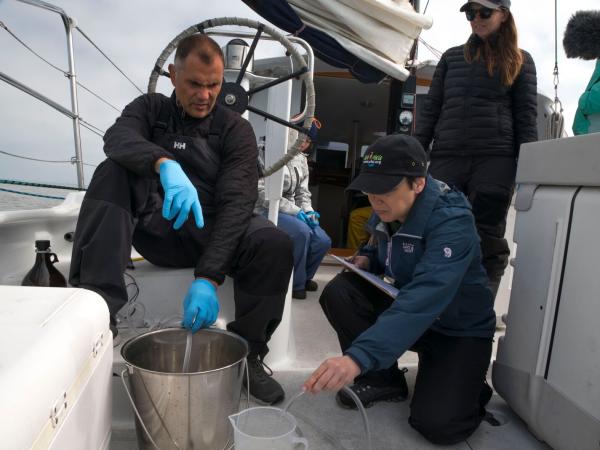New Microplastic Pollution Study to Launch in San Francisco Bay and Adjacent Ocean Waters
Feb 23, 2017
A two-year investigation on microplastic and nanoplastic pollution in San Francisco Bay and the surrounding ocean will launch this month, led by two research centers, the San Francisco Estuary Institute and the 5 Gyres Institute. The project will provide the most comprehensive study in the U.S. on microplastic and nanoplastic levels in water, sediment, and fish and explore ways to reduce this pollution.
Plastic pollution has gained recognition as a threat to the resilience and productivity of ocean ecosystems. However, the scope and impacts of microplastic particles (less than 5 millimeters in size) and nanoplastic particles (less than 0.001 millimeters) on coastal and ocean resources is still emerging. A preliminary study of nine sites in San Francisco Bay, published in 2016, found greater levels of microplastics in Bay surface waters than in either the Great Lakes or Chesapeake Bay. Understanding the sources, pathways and distribution of microplastic pollution is important to the health of San Francisco Bay, and the surrounding ocean environments.
This project is funded by the Gordon and Betty Moore Foundation with additional support from the Regional Monitoring Program for Water Quality in San Francisco Bay (RMP). The RMP’s microplastic strategy, released today and developed by a team of international experts and regional stakeholders, will guide the effort.
Beauty products with plastic microbeads, synthetic clothing, plastic bags, polystyrene foam packaging, and disposable plastic items can all contribute to plastic pollution. Fish, birds, and wildlife eat plastic debris, which can lead to physical impacts like blockages or starvation, as well as exposure to harmful chemicals. Microbeads from beauty products and tiny fibers from synthetic clothing were found at all nine Bay sites examined in the previous study. Both California and the U.S. banned microbeads in beauty products starting in 2017. Microbeads are a small portion of total microplastic pollution. Other sources, as well as associated environmental and health impacts and policy and innovation solutions, are active areas for continued research.
The new research will document microplastic levels in the region’s fish, sediment and surface water, and assess stormwater runoff and wastewater as pathways by which plastic enters the Bay. It will also characterize microplastics outside of the Golden Gate and within adjacent ocean areas, and develop a computer model to illustrate the path of Bay microplastic pollution to the sanctuaries beyond. Based on the findings, the researchers will suggest potential avenues to control pollution, including innovations by private industry, individual behavior changes, and policy options.
A major scientific component of the project is to develop monitoring methods and standards to encourage similar studies across the globe. Novel nanoplastic detection methods will be deployed for the first time as part of this study.
“The Bay Area is an international hub for innovation and forward-looking science,” said Dr. Rebecca Sutton, lead researcher at San Francisco Estuary Institute. “We can lead the search for solutions to this global problem.”
“The project’s microplastic and nanoplastic research will serve much more than the Bay Area,” said Carolynn Box, Environmental Programs Director at 5 Gyres. “We are researching so many components of the issue – fish, sediment, surface waters, stormwater, and wastewater – and working with experts to come up with policy recommendations based on what we find. This will have impacts locally and also globally as we intend to share the results and recommendations widely.”
The San Francisco Estuary Institute is a California-based, not-for-profit organization that strives to promote enlightened environmental planning, management, and policy development based on sound science. SFEI scientists work to inform pollution prevention and other management measures in order to protect water quality. Visit sfei.org or follow @sfei_asc.
The 5 Gyres Institute is a nonprofit organization based in Los Angeles, California, with a global network of supporters dedicated to a planet free of plastic pollution. 5 Gyres’ mission is to empower action against the global health crisis of plastic pollution through science, art, education, and adventure. Visit 5gyres.org or follow @5gyres.
The Gordon and Betty Moore Foundation fosters path-breaking scientific discovery, environmental conservation, patient care improvements and p reservation of the special character of the Bay Area. Visit Moore.org or follow @MooreFound.
Associated Staff:
Other Contributors:
Carolynn Box
Programs and Focus Areas:
Clean Water Program
Microplastics







